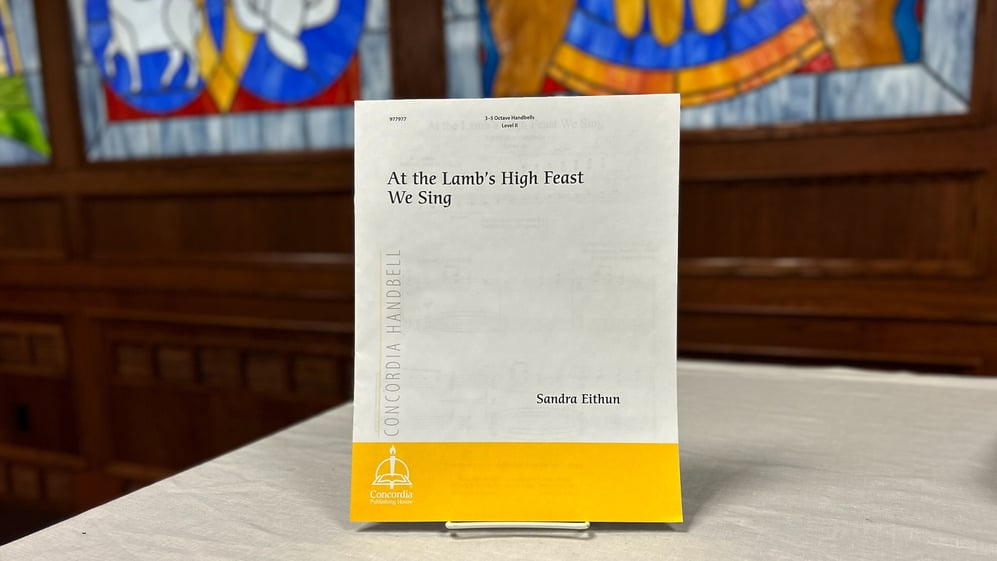Triumphant and upbeat, Sandra Eithun’s setting of “At the Lamb’s High Feast We Sing” has limited bell changes and few rhythmic challenges, making it easy to prepare for developing ensembles. The LV passages, martellato, and varied dynamics add interest for the listener and help to encourage musicality in the ringers.
Using This Piece for Easter
Eithun’s setting is an appropriate piece for church handbell choirs to prepare for Eastertide throughout March. The setting contains a lovely ritornello theme and states the melody twice. The piece should be accessible for less-experienced ringers and ensembles and would be a great reason for a church that perhaps hasn’t used its handbells as frequently to revisit handbell repertoire.
This setting would be suitable for the entire Easter season but could especially be a nice match for one of the latter services of the Paschal Triduum: the Vigil of Easter on Holy Saturday or Easter Sunday. Because of the hymn’s connection to the Sacrament of the Altar, it would be fitting to place the piece during the distribution of the Lord’s Supper at one or both of those services.
For the churches that celebrate the Easter Vigil the evening prior to Easter Sunday, handbell ensembles could get extra mileage out of this piece by using it both at the Vigil and on Easter morning. “At the Lamb’s High Feast We Sing” is also the Hymn of the Day for the Fifth Sunday of Easter in all three cycles of the Three-Year Lectionary, so ensembles can be ready to pull the music out again to play near the end of the Easter season.
The Hymn: “At the Lamb’s High Feast We Sing”
The hymn “At the Lamb’s High Feast We Sing” is an ancient text, originally written in Latin prior to the eighth century. Its exact origin is unknown, but the meter of the text suggests it comes from the fifth or sixth century.
The hymn was translated into English by Robert Campbell (1814–68) in 1850 and became familiar to The Lutheran Church—Missouri Synod after it was included in Worship Supplement (1969). Subsequently, it appears in Lutheran Worship (1982) and Lutheran Service Book (2006). In LSB, the hymn is located in the Lord’s Supper section, although it is commonly associated with the Easter season. Nevertheless, the hymn focuses primarily on the “high feast” of the resurrected Lamb of God, and it’s a fitting hymn to sing whenever the Lord’s Supper is celebrated throughout and after the Easter season.
The Text: The Resurrection and the Lord’s Supper
The hymn text unites two themes that Christians have historically celebrated together: the resurrection of Jesus Christ from the dead and the presence of the crucified and risen Lord in the Sacrament of the Altar. The first stanza introduces both themes:
At the Lamb’s high feast we sing
Praise to our victorious King,
Who has washed us in the tide
Flowing from His pierced side.
Alleluia!
(LSB 633:1)
The Lamb—the victorious King—is Christ Jesus, raised from the dead after His crucifixion for the sins of the world. Now risen from the dead, He invites His Church to the high feast: the marriage supper of the Lamb in His kingdom. This feast is not only the eternal feast of victory in heaven, but it is given to the Church even now. His body and blood under the bread and wine on the altar at the Divine Service, given to Christians to eat and drink, is a foretaste of that heavenly feast.
This eucharistic feast, instituted at the Last Supper on Maundy Thursday, just before Christ’s death on Good Friday, is celebrated in remembrance and proclamation of His death and resurrection until He comes again. It gives the fruits of the cross—forgiveness, life, and salvation—to all who believe the words “given and shed for you for the forgiveness of sins.” The risen Christ is made known to us through the reading of the Word and the breaking of the bread—just as the disciples recognized Jesus through these means on the road to Emmaus after His resurrection (see Luke 24:13–35).
Those fruits of the cross flow from the pierced side of the crucified Christ. They are found in the waters of Holy Baptism and in the blood of the cup of the New Testament. Each stanza of the hymn concludes with a resounding “Alleluia!” After the Church fasts from its “Alleluias” throughout the season of Lent, they are sung with joy and gladness once again at the news that Christ is risen.
Prepare this handbell setting for your Eastertide worship by ordering copies of the sheet music today.










.jpg?width=50&height=50&name=TM009668%20(1).jpg)


